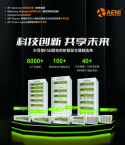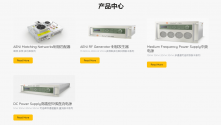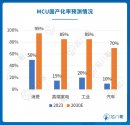You are using an out of date browser. It may not display this or other websites correctly.
You should upgrade or use an alternative browser.
You should upgrade or use an alternative browser.
Chinese semiconductor industry
- Thread starter Hendrik_2000
- Start date
- Status
- Not open for further replies.
good questionWhen would CXMT release LPDDR5X?
looks like 2025. They need to put D1z (aka G4 technology) into production before they can get here. But since Samsung just got here a year ago, CXMT getting here by 2025 is not bad at all
Although looks like they announced the product back in late 2021
so imo, it goes something like this
validation with Xiaomi/Transsion this year on LPDDR5
mass production in Q2 with G3 tech
mass production later in 2024 with G4 tech
mass production in 2nd half of 2025 with 16/18GB LPDDR5x and D1z
And that's good enough to go into medium end smart phones probably or even Huawei phones if they are desperate
By then, domestic tools are also good enough so they don't need to be concerned about sanctions
good question
looks like 2025. They need to put D1z (aka G4 technology) into production before they can get here. But since Samsung just got here a year ago, CXMT getting here by 2025 is not bad at all
Although looks like they announced the product back in late 2021
so imo, it goes something like this
validation with Xiaomi/Transsion this year on LPDDR5
mass production in Q2 with G3 tech
mass production later in 2024 with G4 tech
mass production in 2nd half of 2025 with 16/18GB LPDDR5x and D1z
And that's good enough to go into medium end smart phones probably or even Huawei phones if they are desperate
By then, domestic tools are also good enough so they don't need to be concerned about sanctions
Well IMO the real problem for CXMT is that the LPDDR5 demand will be way higher than what they can supply.
Juts for reference all current , , and even all the chips but the 8 series (i.e. 4, 6 and 7 series) use LPDDR4x or LPDDR5 memory. Only the very high end Snapdragon 8 and Mediatek Dimensity moved to LPDDR5x.
The big issue for CXMT, YMTC and SMIC at the moment is to ramp up production of their current advanced nodes. They will easily sell all advanced chips they are able to produce, at least for the foreseeable future.
Ramp up production is the huge and very hard challenge for them considering that also exports of ASML DUVi machines starting 2024 will be limited and that the largest part of the domestic replacement for other kind of equipment is currently still in validation phase for advanced nodes below 28nm.
Apart from lithography, that is a (big) separated topic, Chinese SME have conquered 28nm in 2023. It will take them the whole 2024 and IMHO also 2025 to move down to 7nm for volume production.
Ankai Micro: 8K pixel products are in the research stage
Ankaiwei said in an institutional survey that the company's mass-produced IoT camera chips have covered 1 million to 6 million pixels in terms of pixels, and 8 million pixel products have been taped out. Now In verification stage. 8K pixel products are in the research stage. When the product series is further enriched, it will help promote product marketing and increase customer stickiness.
Ankaiwei disclosed specific products. The AK39AV100 uses a 22nm process, has a lightweight 0.5T computing power, supports 5 million to 6 million pixels, and supports dual CIS. It will start mass production in the fourth quarter of 2022 and has continued to ship so far. Demand is relatively strong. AK39AV100 is mainly used in home cameras, security cameras, etc., supporting a wider and farther visual range. The AK39EV series does not currently support dual CIS.
In terms of cost, compared with the solution where two main control chips support dual CIS, one main control chip supports dual CIS. First, it can save one chip. At the same time, the direct cost of peripheral components and PCBA boards is also reduced. There will be certain advantages; for end users, the same product functions and performance can be achieved, and for terminal manufacturers, the solution of one master controller supporting dual CIS has obvious cost advantages after mass production.
At present, Ankai Micro's project using the 12nm process is in the research stage. According to the project plan, it will first target IoT camera chips. In the future, Ankaiwei will also determine whether to use this process in other projects based on market demand and project development needs.
Another supplier of manufacturing equipment parts expanding offerings DC power and RF matching for semiconductors and FPD, they also serve other sectors like medical and industrials applications.
Shanghai AENI Semiconductor Technology Co., Ltd.
Shanghai AENI Semiconductor Technology Co., Ltd.
Epecializes in manufacturing and is China's flagship company. AENI was founded in 2000 and is a famous Chinese RF technology brand. It specializes in R&D, production and assembly of semiconductor-level RF generators (RF Generator) in China. A leading company in RF Match and RF components. Co-founded by a team of returnees studying abroad, it has always followed the path of "independent research and development, technology-based enterprise", product frequencies cover 400KHZ, 13.56MHZ, 2MHZ, 27MHZ, 60MHZ, 162MHZ, product functional indicators, frequency sweep function, RF accuracy, conversion Efficiency, etc. can fully satisfy the semiconductor FAB wafer manufacturing process and pan-semiconductor solar cell, LED, flat panel display industries, as well as universities, research institutes, data storage, ITO conductive glass, industrial coating, medical imaging MRI nuclear magnetic resonance, magnetron sputtering , plasma generation equipment and other various production processes, including PVD physical vapor deposition, PECVD plasma enhanced chemical vapor deposition equipment, CVD chemical vapor deposition, ETCH etching process, IMP ion implantation, ASHER ion degumming and other process technology processes.
The company is headquartered in Shanghai Songjiang Economic and Technological Development Zone. The factory has a total area of more than 8,000 square meters and currently has more than 100 R&D, production and assembly employees. It implements a strict product quality management system and has passed ISO9001:2015 quality certification and EU CE safety certification. , Rohs material safety certification. The company adheres to the concept of "innovation as the source, integrity as the basis, quality first, service first", and at the same time takes "comprehensive quality, zero-defect thinking" as the benchmark, actively develops diversified technology projects in the industry chain, and provides high-quality products and solutions.
After more than 20 years of technological accumulation and intensive cultivation, Ian'e has independent innovation and research and development capabilities in the field of domestic radio frequency technology, and its core technology has reached the industry-leading level. It has broken foreign technology monopolies and technical barriers in many aspects, and has more than 40 national patents. Invention patents and PCT international patents are gradually becoming the leading partner of Chinese semiconductor wafer FAB manufacturers. The company has also been selected as a national high-tech enterprise, a member of the National Integrated Circuit Components Innovation Alliance, and a governing unit of the Shanghai Integrated Circuit Association.
In the future, IA will make the most efforts in RF generators and RF matching products to build a benchmark enterprise in China's semiconductor RF technology and a world-class semiconductor RF technology company.


The company is headquartered in Shanghai Songjiang Economic and Technological Development Zone. The factory has a total area of more than 8,000 square meters and currently has more than 100 R&D, production and assembly employees. It implements a strict product quality management system and has passed ISO9001:2015 quality certification and EU CE safety certification. , Rohs material safety certification. The company adheres to the concept of "innovation as the source, integrity as the basis, quality first, service first", and at the same time takes "comprehensive quality, zero-defect thinking" as the benchmark, actively develops diversified technology projects in the industry chain, and provides high-quality products and solutions.
After more than 20 years of technological accumulation and intensive cultivation, Ian'e has independent innovation and research and development capabilities in the field of domestic radio frequency technology, and its core technology has reached the industry-leading level. It has broken foreign technology monopolies and technical barriers in many aspects, and has more than 40 national patents. Invention patents and PCT international patents are gradually becoming the leading partner of Chinese semiconductor wafer FAB manufacturers. The company has also been selected as a national high-tech enterprise, a member of the National Integrated Circuit Components Innovation Alliance, and a governing unit of the Shanghai Integrated Circuit Association.
In the future, IA will make the most efforts in RF generators and RF matching products to build a benchmark enterprise in China's semiconductor RF technology and a world-class semiconductor RF technology company.


Equipment manufacturer Jingsheng Co., Ltd. announced that the headquarters production and R&D center project has capped
On November 28, Jingsheng Co., Ltd. announced that the company’s headquarters production and R&D center project has been capped. Jingsheng Shares stated that the "Headquarters Production and R&D Center Construction Project" is to expand production capacity on the basis of the company's existing main business, and at the same time carry out technological research and development and upgrades of crystal growth equipment and crystal growth processes to accelerate the industrialization of R&D results. Help companies expand product lines to better meet customer needs.
Information shows that Jingsheng Co., Ltd. was established in February 2012. It is a national high-tech company specializing in the development of 8-12-inch semiconductor-grade single crystal silicon furnaces, 6-8-inch silicon carbide, gallium arsenide and other semiconductor material crystal growth equipment and processes. A technology company that can provide customized crystal growth equipment, processes and technical services to customers of different types of semiconductor materials.
Recently, Jingsheng Shares stated in an institutional survey that the company is actively exploring the Taiwan market and maintaining close technical exchanges with customers. It has already obtained batch orders and the order quantity continues to increase. In addition, the company is also actively developing overseas markets. Jingsheng Technology pointed out that the company's semiconductor-grade monocrystalline silicon furnace and SiC monocrystalline furnace have been successfully delivered and accepted in Taiwan, China, and the equipment performed well at the customer's site. The company's main competitors in Taiwan are foreign equipment manufacturers such as Germany, South Korea and Japan.
Interesting development
Chinese-owned ’s acquisition of chip firm won approval from the Dutch government, which has been probing it on national security grounds.
The Netherlands deemed Nowi’s technology not a threat to national security because it’s not dual-use, Dutch Economic Affairs Minister Micky Adriaansens said in a letter to parliament on Monday, confirming an earlier Bloomberg News report. The move signals that the Netherlands is still open to business with China after a series of US-led export control measures against the world’s second-biggest economy.
Nowi, which produces small chips that make it easier for companies to power their devices with energy harvesting, was bought by Nijmegen-based Nexperia in November 2022. Nexperia was sold to Chinese investors in 2018, when acquired the Dutch chipmaker for 25.2 billion yuan ($3.5 billion).
Netherlands Backs Chinese-Owned Nexperia’s Takeover of Nowi
Chinese-owned ’s acquisition of chip firm won approval from the Dutch government, which has been probing it on national security grounds.
The Netherlands deemed Nowi’s technology not a threat to national security because it’s not dual-use, Dutch Economic Affairs Minister Micky Adriaansens said in a letter to parliament on Monday, confirming an earlier Bloomberg News report. The move signals that the Netherlands is still open to business with China after a series of US-led export control measures against the world’s second-biggest economy.
Nowi, which produces small chips that make it easier for companies to power their devices with energy harvesting, was bought by Nijmegen-based Nexperia in November 2022. Nexperia was sold to Chinese investors in 2018, when acquired the Dutch chipmaker for 25.2 billion yuan ($3.5 billion).
imo, the big challenge is just using domestic tools to do D1z process. That's a pretty tall order for AMEC. Since they claim the tools are getting verified right now.Well IMO the real problem for CXMT is that the LPDDR5 demand will be way higher than what they can supply.
Juts for reference all current , , and even all the chips but the 8 series (i.e. 4, 6 and 7 series) use LPDDR4x or LPDDR5 memory. Only the very high end Snapdragon 8 and Mediatek Dimensity moved to LPDDR5x.
The big issue for CXMT, YMTC and SMIC at the moment is to ramp up production of their current advanced nodes. They will easily sell all advanced chips they are able to produce, at least for the foreseeable future.
Ramp up production is the huge and very hard challenge for them considering that also exports of ASML DUVi machines starting 2024 will be limited and that the largest part of the domestic replacement for other kind of equipment is currently still in validation phase for advanced nodes below 28nm.
Apart from lithography, that is a (big) separated topic, Chinese SME have conquered 28nm in 2023. It will take them the whole 2024 and IMHO also 2025 to move down to 7nm for volume production.
Based on how many ASML machines they have imported in the recent few months, I think they are fine on that front. CXMT might not even have to worry for a few more months since they are on US govt's good side as of now. So they can keep buying more.
- Status
- Not open for further replies.

